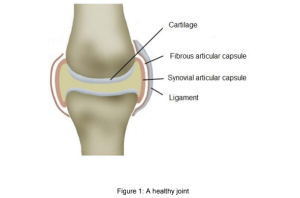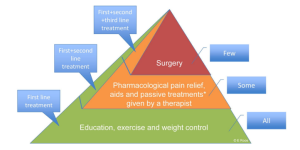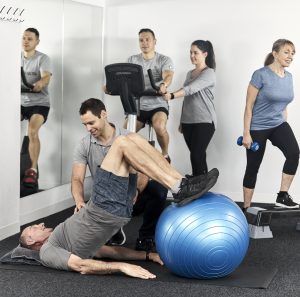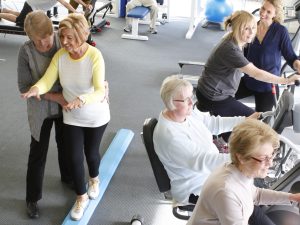What is Osteoarthritis?
Osteoarthritis is a very common disease. Osteoarthritis affects the whole joint, but most of all it affects the articular cartilage (the cartilage covering the ends of the bones). This articular cartilage becomes thin and fragile. This can be due to:
- Healthy cartilage being exposed to heavy loads over a long period of time (for example, very heavy labour over several years), or
- Unhealthy cartilage that for some reason cannot handle normal loads.
Osteoarthritis is the most common cause of difficulties with mobility and disability in older people. It is also common in younger and middle-aged people. Approximately 5% of people between 35 and 54 years of age have osteoarthritis. Many of these people have injured their joint earlier in life.
Approximately 30% of the population between 50 and 70 years of age have problems related to osteoarthritis and the percentage increases in older age groups.

Changes in the Joint with Osteoarthritis
You may have heard osteoarthritis described as ‘wear and tear’ of the joint. This statement is incorrect because loads are still needed to keep cartilage healthy. In a healthy joint, there is a balance between the regeneration and degeneration of cartilage. Osteoarthritis
occurs when there is more degeneration (breakdown) than regeneration of cartilage. This causes cartilage to thin, crack, and maybe disappear. Bones can then start to rub against each other. However, cartilage needs a certain amount of load to regenerate. This is why healthy loads need to be applied on joints for cartilage recovery.
How can you treat osteoarthritis?
Currently, there is no known way of curing cartilage loss. Treatment is used to reduce symptoms and improve function of the joint. Learning about osteoarthritis is part of the treatment. Special exercises can be done to relieve pain and boost joint function. When function improves, the next step is to get more active. Being physically active can help maintain weight loss and improve overall health. These things should be done as early as possible by people who have osteoarthritis. The usual treatment for osteoarthritis is outlined by the pyramid in Figure 3. Below are explanations of each line of treatment organized by colour.

Exercise
Exercise has been shown to be the best treatment for people who have trouble with their osteoarthritis. Exercise reduces pain and makes it easier for people to do their daily activities. Being active can lead to lots of positive things like a strong heart and good overall health. It is easier to control your weight with exercise compared to without exercise.
Exercising also benefits the cartilage
Exercising has added benefit for people with osteoarthritis.
- Nutrients are pumped in and out of the cartilage when it is loaded and unloaded. This promotes growth and reformation of the cartilage which boosts its strength.
- Exercising will have your joints moving through their range of motion. This will make it easier to do everyday things you used to have trouble with (putting on socks, climbing stairs, getting in and out of the car). Exercise helps build stronger muscles, which helps make daily activities easier.
- Exercising will train your coordination; the ability to use the right muscles at the right time with the right amount of force. This will make it easier to control movements like walking on uneven ground.
- The benefits of exercise disappear when you stop exercising. To keep the effects of exercise, you have to keep exercising regularly. This is why it’s important to do exercises that you enjoy
Is it okay to exercise when it hurts?
If you have osteoarthritis and start exercising, you might start to feel pain. The pain may last a while, but it’s not dangerous to keep exercising. Everybody reacts to pain differently. Some people stop activities completely and rest as much as they can. This can lead to even more lost function. Some people ignore pain signals, which can lead to more injuries. It’s normal to feel a bit of pain when exercising. You may have a bit of muscle soreness if
you haven’t used these muscles regularly, or have some joint pain. The muscle soreness will decrease as you get used to exercising. The joint pain should not go over your acceptable limit of pain (see Figure 4). The joint pain should lessen 24 hours after exercise to the same level as before exercise. These pain limits will be different for everyone and can change over time. Lower the intensity of your exercise if joint pain goes over your acceptable limit or continues for over 24 hours. It’s important to listen to your body and strike a balance when exercising. Focus on your exercise goals to distract yourself from the pain. Don’t forget to have fun!

Exercise Recommendations
- Everyone, regardless of injury, illness or age should aim to be physically active for 30 minutes a day.
- These 30 minutes can be done in 10 minute bouts. At least twice a week, these bouts should be 20 minutes long and either maintain or increase in intensity.
- These activities should be slightly difficult and be done on top of your normal everyday activities. This is needed to maintain good health and prevent disease (e.g. diabetes, certain types of cancer, high blood pressure among others).
- These recommendations apply to people with osteoarthritis. The ideal type and amount of exercise depends on the person’s age, abilities, functional limitations, and health status. If you have not been physically active in the past, it may be a good idea to start slowly. See how you feel, and then gently increase the intensity.
Reference: GLA:D Australia Participant Information




